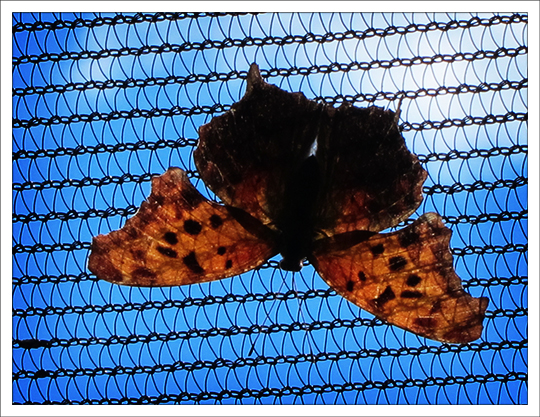Butterflies of the Adirondack Mountains:
Question Mark (Polygonia interrogationis)
 Butterflies of the Adirondacks: Question Mark in the Paul Smiths VIC Butterfly House (13 June 2012)
Butterflies of the Adirondacks: Question Mark in the Paul Smiths VIC Butterfly House (13 June 2012)
| This page is no longer being updated. For an updated version of this material, see: Question Mark (Polygonia interrogationis). |
The Question Mark (Polygonia interrogationis) is a medium-sized orange and black butterfly that may be seen in the Adirondack Mountains of upstate New York in the summer months. It is a member of the Brushfoot family. [1] The Question Mark is one of the Anglewings, named for the jagged edges of their wings. The genus name is derived from the Greek word polygonos, which means "many angled." [2] The species name is from the Latin interrogatio, meaning "question." [3] This is a reference to the small silvery question-mark on the hind wing when viewed from below. [4] This butterfly was once known as the Violet-Tip -- a reference to the violet sheen on the edges and undersides of their wings. [5] [6]
From above, the Question Mark is orange or reddish orange with dark spots. From below, this butterfly is light gray-brown and relatively unmarked. [7] The fore wing is hooked. [8] One of the identifying characteristics is that this butterfly is the only anglewing with a small black horizontal bar on the fore wing. [9] The Question Mark has two seasonal forms. [10] The hind wing of the summer form (form "Umbrosa") is darker from above; the upper side of the hind wing is almost black. [11] [12] The winter form has longer tails and a largely red-orange dorsal hind wing. [13] The Question Mark's flight is robust, with slower wing flaps than those of the similar Eastern Comma. [14] The Question Mark is also somewhat larger: its average wing span is 2.5 inches. [15]
Male Question Marks find females by perching on leaves or tree trunks in the afternoon. [16] [17] Females lay their eggs at singly or stacked under leaves of plants that are usually not the hosts.[18] The light green eggs are keg-shaped and ribbed. [19] The caterpillar must find a host plant. [20] Host plants include nettles, false nettle, Japanese hop, American elm, and hackberry. [21] [22] [23] [24] Caterpillars are spiny and variable in color. [25] [26] [27] They may have four rows of orange spines behind the head. [28] Adult Question Marks consume tree sap, rotting fruit, dung, or dead animals. [29] Only when these are unavailable will Question Marks visit flowers for nectar. [30] [31] [32] [33] Adults reportedly live for six to twenty days. [34]
In terms of ecology, the Question Mark is a generalist.[35] It can survive in a variety of habitats, including deciduous woods with some open space, glades, city parks, orchards, edges and stream sides. [36] [37] [38] This butterfly occurs from the Maritime Provinces west to the eastern foothills of the Rocky Mountains. [39] The Question Marks' range includes all of the eastern US, except for the Florida peninsula. [40]
Question Marks are migratory. [41] Although some Question Marks overwinter in the North, depending on the severity of the winter, [42] [43] many migrate south in the fall. [44] [45] There is also a definite northward migration in the spring, although it is less dramatic. [46] [47] [48] The summer form of the Question Mark emerges and normally flies from June to early August in the north; [49] they lay eggs that develop into the winter form. Winter-form Question Marks appear in late August and spend the winter in various shelters. [50]
This butterfly is highly variable in abundance. [51] [52] Question Marks are commonly seen in the New York City area of New York State in mid-June, late July, and early October, less common in late May, August, and September. [53] In 2012, Question Marks were seen in the Adirondack Park in June and July and in the Paul Smiths VIC Native Species Butterfly House and adjacent Butterfly Garden in June and early August. [54]
References
- Susan Grimm Hanley. Interpretive Naturalist, Paul Smith's College Native Species Butterfly House. Species Logbooks.
- Butterflies and Moths of North American. Species Profiles. Sighting records: 6/9/12; 6/13/12
- Government of Canada. Canadian Biodiversity Information Facility. SpeciesBank.
- Massachusetts Butterfly Club. Massachusetts Butterfly Species List.
- ENature. Field Guides.
- Iowa State University. Department of Entomology. BugGuide.
- Ross A. Layberry, Peter W. Hall, and J. Donald Lafontaine. The Butterflies of Canada (University of Toronto Press, 1998), p. 197, Plates 16 and 21.
- National Audubon Society. Field Guide to Butterflies (New York: Alfred A. Knopf, 1981), pp. 609-610.
- Jim P. Brock and Kenn Kaufman. Kaufman Field Guide to Butterflies of North America (Houghton Mifflin, 2003), pp. 196-197.
- Paul A. Opler. A Field Guide to Eastern Butterflies (The Peterson Field Guide Series, Houghton Mifflin Company, 1992,1998), pp. 50-51, 86-87, 261-62.
- Jeffrey Glassberg. Butterflies of North America (Michael Friedman Publishing, 2002), pp. 144-145.
- James A. Scott. The Butterflies of North America. A Natural History and Field Guide (Stanford University Press, 1986), pp. 284.
- Donald and Lillian Stokes. Stokes Butterfly Book. The Complete Guide to Butterfly Gardening, Identification, and Behavior (Little, Brown and Company, 1991), pp. 68-71.
- Jeffrey Glassberg. Butterflies through Binoculars. The East. A Field Guide to the Butterflies of Eastern North America (Oxford University Press, 1999), p. 117, Plate 33.
- Paul A. Opler and George O. Krizek. Butterflies East of the Great Plains: An Illustrated Natural History (The Johns Hopkins University Press, 1984), pp. 150-151, Plate 26.
- Rick Cech and Guy Tudor. Butterflies of the East Coast. An Observer's Guide (Princeton University Press, 2005), p. 180.
- Thomas J. Allen, Jim P. Brock, and Jeffrey Glassberg. Caterpillars in the Field and Garden. A Field Guide to the Butterfly Caterpillars of North America (Oxford University Press, 2005), pp. 94-95.
